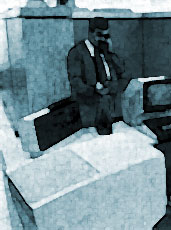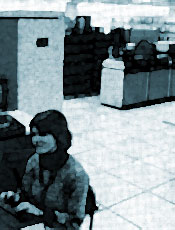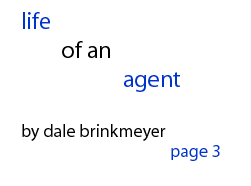 |
 |


Memphis, TN
Title: Customer Service Supervisor, Station Trainer, and Load Control Instructor
Yes, back to another of my old haunts. The greeting .. "We are having a NASIF inspection". This is not an unusual thing to occur right after a merger. The purpose is to make sure it’s one airline running as the documentation says and also is safe. Within days of my arrival, the Northwest person whom was put in charge of the Load Control systems greeted me. This was the same person who gave me my original Northwest Load Control instruction in Minneapolis. With my background as a supervisor, trainer and knowledge of Load Control, I was given the task of getting the Load Control area in Memphis ready to pass a “White Glove” test. At least I was off the Ticket Counter. No problem with the agents working in the area, however, training in the back up system was needed along with a complete overhaul of the documentation systems and a very short time to accomplish it. PASSED!
During my time in the Memphis Station Load Control arena, Northwest purchased the PARS reservation system to replace the Polaris system. Now remember, the ESCORT system was a derivative of PARS with many enhancements. Think of what kind of system we could have had if it had been retained instead of POLARIS. All customer service agents would get training in the PARS system except for those in Load Control, as they would not be working in the customer service field in the near future. However, when and if the time came, we were promised to get the training if needed. The decision to purchase the PARS system was an excellent one. It was one of the systems preferred by many of the travel agencies, who are major players in the airline industry’s bottom line. With PARS, we again had a good system along with a major influence in travel agency bookings.
Soon after the cut over to the PARS system, there was a station rebid of work schedules and I was unable to retain my slot in the Load Control office. I was now assigned to the gate areas. I do not believe in supervising an area where I am not capable of operating the computer systems. I asked for the training and was informed there were no more classes scheduled. Okay, allow me some time to do some of the computerized lessons. I was told I would not need this knowledge and just take care of the other items. My answer became very simple. I bid back to an agent in the Load Control area and was awarded the position within a very short time. My days of being a supervisor had now come to an end.
Back into a work environment I enjoyed but found very boring in many ways. I needed more of a challenge. By this time I was or had been certified in five different Weight and Balance systems over the years, but there was a notice posted in our office requesting a couple of people to spend a month in Minneapolis learning a new computer program and then teaching it system wide over the next couple of months. I did not know at the time that it would be another computerized Weight and Balance system. I put my name in the hat and within a week, was on a flight to Minneapolis. It was there I was introduced to the Worldflight system. My initial reaction was that the system was clumsy, but I knew it was going to lead to a centralized office for this task. As I would not work in the Memphis airport station again, I will continue my story at my next stop along the way .. Memphis Central Load Control .. CLC .. And will continue my journey there.

Memphis, TN .. Central Load Control
Title: Load Control Agent, Instructor and Assistant Manager
Little did I realize when I became involved with Worldflight my days of being in the front line were about to come to and end until just before my retirement. There was a group of core people who had been working on this project for a couple of years. Added to this group were 2 agents each from Memphis, Detroit, and the Minneapolis station who would become the instructors. At the time, about 1800 agents were certified to work Load control. We would end up training about 1200.
As soon as the training was complete we had the cut over to the new system on Thanksgiving weekend. Again you can see all things new that can become a complete disaster are geared for a heavy travel period. I was on the help desk over this time in the middle of a blizzard in Minneapolis. It was also announced that this work would be in a consolidated office and the location would be Memphis. My sense of humor almost .. well maybe it did .. got me in trouble again. I found a cartoon with people building Stonehenge and a person running up to the site saying “No, stop, we have made a mistake in the location” at the bottom .. I put the caption “Memphis” over the word Stonehenge, enlarged it and posted it on the board in Minneapolis. It was swiftly taken down. This office could have been located anyplace and I was going to follow the job. However, with Memphis being the location, I would not have to move again. Most airlines now work with a central Load Control office environment today.
What would this office do? It would gather as much information via historical flight histories and in conjunction with the stations, assemble a loading plan for each flight. After the loading was complete, the actual information was sent to this office via computer. The data would be checked for accuracy and safe operation of the flight. Remember, everything has limits and aircraft are no different. Some of the limits are dictated by certified lift off weight, some by volume, and some by enroute fuel burn. Some of these limits are further restricted by weather; temperature, snow, ice and rain amongst them. The final take off and flight setting numbers would then be sent to the pilot again via a computer system. These agents had to be very proficient in knowing the limits and loading requirements for every type of aircraft Northwest was flying. There would be regular audits done not only on the flight papers, but also on the agent’s knowledge and ability.
Aircraft normally have two major loading areas, one forward and one aft. Load plans were set up to have luggage loaded by type when the flight was going into a major hub. Luggage getting off locally at the hub loaded in one area and the transfer luggage loaded in the other area. This allows for two groups of ground agents to move the luggage in an efficient manner with the passenger. The remainder of space or weight available would be used for other types of cargo such as mail and air freight. When the flight was going to what was termed a “Spoke” station, the luggage would be loaded either all aft (preferably) or all forward and the remainder of the cargo in the other end of the aircraft. Why luggage in the aft? When an aircraft arrives at a station there is a lot of activity going on at the forward part of the aircraft. From hooking up electrical connects to catering trucks servicing the cabin of the aircraft and refueling. Not much goes on at the aft part of the aircraft.
With the decision made to centralize this part of the operation, the planning, equipping and training would now begin. I was assigned to this office primarily to instruct. Until the actual classes would begin, I was involved in the planning stages and also setting up the type of instruction and procedures that would be used. The agent jobs would be a bid position treated as a new station within the domicile of Memphis. Original planned number of people doing this work was set at 100. Yes, going from 1200 to 100. Needless to say, the training, procedures and systems would have to be set up first rate. As efficient as the office proved to be, it never required 100 agents and if my memory serves correctly, the most we had was in the mid 80s. Why so many .. the office was open 24 hours a day every day of the year. We would work flights from all over the world except where labor laws prevented us from doing so. Computer enhancements and procedures would gradually reduce this number further.
The first groups of people bidding into the new office were very experienced. So, even though the training would consist of what is called A to Z to eliminate overlooking anything, emphasis would be more on breaking bad habits, using new procedures and doing everything the same. Classes would be limited to 12 agents at a time. These first groups would test my knowledge at every turn. They loved nothing better than to “Stump the Instructor”. One thing I had learned previously in my times as an instructor was you don’t need to know every answer, but where to find it and return the next day at the latest with the answer. There were three other primary instructors besides myself. We used two instructors per class with two 8 hour classes each day. Training classes would last four weeks. These other three were excellent instructors and also were involved with setting up the office. The instruction included the computerized program plus the manual systems in case of computer outages. About the time I finished training the third group on the manual system, there was an outage. I took my class for “On the job training” and it worked out well. Keep in mind, only people certified and monthly audits kept up to date are able to do this type of work.
The class was so called “Thrown to the Wolves”. They not only survived, but set up procedures and standards of excellence still used today. The first stations weight and balance work moved into the office was Memphis. Stations would be added as groups would be trained until all stations would be included. By the time the instruction ended, I was way behind the procedural curve and had to sit with one of my former students to learn office procedure. It is not a bad thing to swallow ones pride every now and then and become the student.
At an early age I had set a goal for retirement at age 55. After 10 years in this office, I was fast approaching this goal. I also knew through experience that it took about two years after a move to become comfortable in the new city and life style. So, I again looked to the bid files for an opening in an area I thought I might want to retire. With my time with the company, I was now able to bid openings and place bids on file and get the bid when available. Hey, most people at my age don’t move very often. It’s a young person’s game. (grin) I submitted bids for five different locations and was awarded .. Phoenix, Arizona .. PHX .. Yes I was returning to one of my favorite haunts again .. And I will continue my journey there.

Phoenix, AZ
Title: Customer Service Agent, Central Load Control Trainer for MSP Load Control
I had not been on the front lines for many years and now found myself in a new hire class. After 15 years of being in the Load Control arena, customer service procedures and computers systems had passed me by. Up until this time, I had not received PARS training. Okay, so I had lived a sheltered life for many years. Now for the “what can will go wrong” item. About half way through the training, I was put on medical leave for three months. When I would return to the active roster, I was not back in a class to finish my training but had to report immediately to the Phoenix station. After about six months of on the job training, I would be sent to the remainder of the training classes. Yes, there were many days I just wanted to walk away from it all .. THANK-YOU Phoenix staff for all the patience with me and teaching me the “new and improved methods”.
What had changed? Here is a short list .. advanced seat reservations .. boarding card printers .. boarding card readers at the entrance to the aircraft. Security procedures had changed drastically. Computer check-in without agent assistance; and tickets .. hand written items were now a thing of the past. All paperless travel. The large tariff book was no longer on the ticket counter .. Everything was programmed into the computer. Luggage tag printers. Yes, I was a dinosaur in the modern world.
In a very short time, I was about 5 months away from my targeted retirement date and it was announced the Load Control Office would be moved from Memphis to Minneapolis. I was asked to assist in setting up and training for this new office, as very few people were planning on relocating to Minneapolis, a three month project. I accepted for personal reasons, not realizing it would stretch into a seven-month project. This would be a fun time. Many of the people involved with the Memphis Central Load Control set up project would be involved. If you remember my mention of the instructor for the Northwest methods in Denver 3rd time around .. well, he was named the manager of the relocated office .. And yes, he still owes me a “beer”. This would also offer me the opportunity to finish my career doing what I enjoyed most; working on special projects and teaching.
Setting up the office was left to other people, while I was involved mostly with the training aspects. Many computer enhancements had been implemented so the training manuals needed to be rewritten. Load plans were now computer generated per company standards with certain limits sent out sight unseen. When the final numbers for cargo and passengers were sent from the stations after passing computer checks, they were sent to the pilot sight unseen. If any problems occurred, the agent was alerted for corrective action even if it meant reloading the entire aircraft. The only major aircraft groups worked up by the agent with computer assistance were the large aircraft types .. 747, DC-10 and like type of equipment. The training took a little longer than anticipated and was during the months of September through January. I was ready to get out of the snow and cold again and back to sunny, warm Phoenix. This was not to be. Another carrot was offered to me.
Starting in the early 90’s, most major airlines aligned themselves with small feeder airlines and, besides carrying the major’s name, it included the word “Link”. The actual names of these airlines were often not widely known. One of these airlines carrying the Northwest Link name was Mesaba Airlines. It was, as many were, partially owned by Northwest Airlines. Many times, work for one of these was accomplished by the major airline involved; mostly in the customer service and normal day to day functions. Northwest at the time was working the Load Control functions and it was decided to turn this aspect over to Mesaba. Sounds simple to start with. However, in order to do this, a complete program for training, system type, agent certification and usage would have to be put into writing and approved by the FAA. I was asked to assist Mesaba in getting all this accomplished. In other words I was “Farmed Out,”
After completing the work with Mesaba Airlines, I was released back to the Phoenix station. I was now over 55 and had completed 36 years with the airline. Even though I was only gone from the front line for a short time, many things had again changed and I found myself once more a “Dinosaur” in the modern airline world. However, I thought “Maybe working a couple of more years would not be so bad.” Unbeknown to me at the time, there was a pool by some of the employees to see how long it would be before I retired. How long would it be .. a month.
Each work group has the last day traditions. Customer service agents are no different. On your last day, you swipe in on the time clock never to swipe out again. I do not know if this is a company requirement or tradition. On this day, I dressed in the full “Class A” uniform .. swiped in .. went to a back room .. changed into golfing attire .. folded up my uniform .. placed all my keys and badges on top .. and deposited this pile on the supervisors’ desk .. departed the office no longer an active employee. I am now retired .. and you can now call me anytime at 1-800-RETIRED. (And yes I am enjoying it)
Dale............The Last of the Good Guys from the Badlands
<<< page 2
